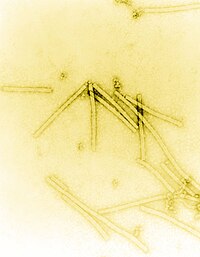
Photo from wikipedia
A modified virus vector permits better plant gene fragment retention and improves gene-silencing phenotypes in the host. Virus-induced gene silencing (VIGS) is used extensively for gene function studies in plants.… Click to show full abstract
A modified virus vector permits better plant gene fragment retention and improves gene-silencing phenotypes in the host. Virus-induced gene silencing (VIGS) is used extensively for gene function studies in plants. VIGS is inexpensive and rapid compared with silencing conducted through stable transformation, but many virus-silencing vectors, especially in grasses, induce only transient silencing phenotypes. A major reason for transient phenotypes is the instability of the foreign gene fragment (insert) in the vector during VIGS. Here, we report the development of a Brome mosaic virus (BMV)-based vector that better maintains inserts through modification of the original BMV vector RNA sequence. Modification of the BMV RNA3 sequence yielded a vector, BMVCP5, that better maintained phytoene desaturase and heat shock protein70-1 (HSP70-1) inserts in Nicotiana benthamiana and maize (Zea mays). Longer maintenance of inserts was correlated with greater target gene silencing and more extensive visible silencing phenotypes displaying greater tissue penetration and involving more leaves. The modified vector accumulated similarly to the original vector in N. benthamiana after agroinfiltration, thus maintaining a high titer of virus in this intermediate host used to produce virus inoculum for grass hosts. For HSP70, silencing one family member led to a large increase in the expression of another family member, an increase likely related to the target gene knockdown and not a general effect of virus infection. The cause of the increased insert stability in the modified vector is discussed in relationship to its recombination and accumulation potential. The modified vector will improve functional genomic studies in grasses, and the conceptual methods used to improve the vector may be applied to other VIGS vectors.
Journal Title: Plant Physiology
Year Published: 2017
Link to full text (if available)
Share on Social Media: Sign Up to like & get
recommendations!